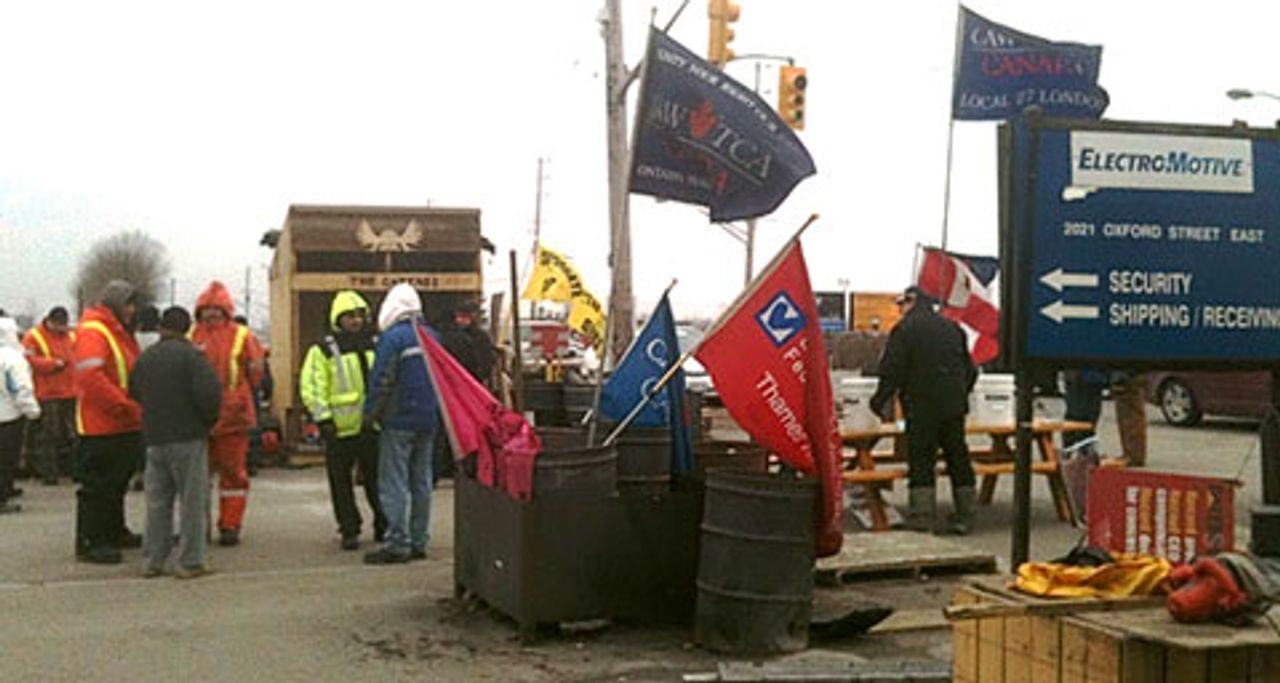 Workers at the Electro-Motive Diesel plant in London, Ontario, have vowed to prevent Caterpillar from removing nine nearly-completed locomotives and machinery from the plant until a satisfactory agreement is reached on severance pay.
Workers at the Electro-Motive Diesel plant in London, Ontario, have vowed to prevent Caterpillar from removing nine nearly-completed locomotives and machinery from the plant until a satisfactory agreement is reached on severance pay.Picket lines remain up outside the Caterpillar-owned Electro-Motive Diesel plant in London, Ontario as the 465 production workers at the plant press their demand for proper severance pay.
On Feb. 3, Caterpillar announced it was abandoning its attempt to force the workers to accept a 55 percent wage cut and other sweeping contract concessions and was transforming a six-week-old lockout into a plant closure.
The Canadian Auto Workers (CAW), the workers’ bargaining representative, quickly acquiesced to the plant’s closure, announcing that henceforth it would focus its efforts on negotiating a severance package.
CAW President Ken Lewenza has said that if Caterpillar, which registered a record $4.9 billion profit in 2011, balks at giving the workers severance pay significantly above the meager amounts mandated under Ontario law, the union may sanction a plant occupation. But the CAW leadership has emphasized it will do so only as a last resort.
 Workers have established a "Jobs Cemetery" outside the London plant to draw attention to Caterpillar's indifference to the social impact of its rapacious drive to maximize profits. The crosses bear the names and dates of service of some of those whose jobs have been destroyed.
Workers have established a "Jobs Cemetery" outside the London plant to draw attention to Caterpillar's indifference to the social impact of its rapacious drive to maximize profits. The crosses bear the names and dates of service of some of those whose jobs have been destroyed.Moreover, any such action would be limited to a protest over the terms of the plant closure. It would not challenge the company’s “right” to close the plant, let alone be organized to spearhead a mobilization of workers across North America against all concessions and in defense of all jobs.
A World Socialist Web Site reporting team spoke with workers picketing outside the Caterpillar-owned Electro-Motive Diesel (EMD) plant last Friday.
Many voiced agreement with the call made in a recent WSWS statement for a united struggle of Canadian and US workers against the big business offensive on jobs and living standards. (See: Fight Ontario Caterpillar plant closure! Unite North American workers against wage-cutting!)
Jay Macintosh, who has worked at EMD’s London plant for nearly five years, told the WSWS that the CAW has provided no information about the closure agreement negotiations. “The union,” said Jay, “has tried again and again to negotiate [with Caterpillar-EMD]. But from the beginning, back in June, it was a ‘take it or leave it’ offer and basically that’s all it’s ever been. Hopefully they’ll come through with a fair deal and we won’t have to go that route and occupy the plant. But if it comes to that I think the membership is ready to do that. ”
Greg has been an assembly worker at the plant for 23 years. “Everyone,” he said, “saw [the CAW negotiators] on the news last night. They looked fairly happy. Everyone’s optimistic to get a settlement and apparently they’re back talking today. We’re supposed to have a meeting Monday, but we don’t know.”
Asked about the possibility of a plant occupation, Greg continued, “With them wanting to get those locomotives offsite that are worth as much as they are and all these parts, they know they’ve got to settle.
“But then we knew of all these orders coming until 2015 and we thought they would negotiate with us. It really wasn’t a serious contract offer. You have to think that they had a business plan when they took it over. We believe the only reason they bought all this was for the engine technology. General Motors sunk millions of dollars into the diesel engines for years before they sold all this off.”
Greg explained how the workers, at the CAW’s urging, had dramatically increased productivity during 2011 because they feared Caterpillar, which bought EMD through its Progress Rail subsidiary, was planning to close the plant.
“[Caterpillar] basically gave us a lowball offer back in June, and said—or we can just extend your contract to work until the end of the year. And the union said, ‘It’s better to fight from the inside. Let’s get back to work, let’s keep at it. Maybe we can negotiate with these people’. And you know we all poured it on.
“150 people left, which was 30 percent of the [workforce]. They took retirements, voluntary termination. So they leave, we bump production up 20 percent. I mean we worked—people really kicked in, we were really producing, with very little overtime. We did everything we could because we were told ‘this will look good toward negotiation time.’ And then—this.
“I was seven years from retirement, but I may go back to school and try to get a better education. Most of us started with grade 12, and there was really no incentive to go back and get more education, because looking at the long term everything looked decent until General Motors decided to bail. I’m in a better situation than some. Some people started in the last six or seven years; they have a family. It’s really tough for them. They were all laid off for a couple of years and they just got back working in the last year or so.”
Andrew has been working at the plant for just over five years. He too believes that Caterpillar probably had intentions of closing the plant when they bought it through their Progress Rail subsidiary. “If,” said Andrew, “they’re going to find workers cheaper somewhere else, then they’re going to just move around and lower the standards. Pretty soon it’s going to be $4 an hour, 12-hour shifts, seven days a week.
“They don’t have to give me any severance according to Ontario labor law. Hopefully the rest of the membership sticks together and helps the guys who have under five years’ [seniority] to get our fair share. The idea of occupying the plant is a valid proposal. It’s an option, but it’s our last resort.”
Pat, a worker with 23 years at the plant, is determined to continue the fight for a decent severance package. He was not hesitant to speak about the possibility of an occupation. “It might be what we have to do here. We’re not going to walk away with nothing. I’ve given these guys my whole life, my whole career. I’m 53 years old—who do you think is going to hire me, and at what rate?
“I agree that it’s time for the Canadian and U.S. unions to get back together. I think the general public is going to have to rally together with one cause, one focus to equal out what the executives are getting. We deserve our share too because we’re the ones that are making the money for these executives. This was just a test what Caterpillar did here: ‘How far can we take this in Canada?’ Like Andrew said, it’s a [corporate-imposed] race to the bottom.”
